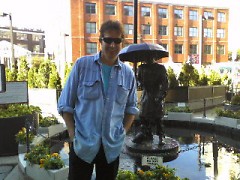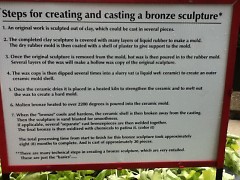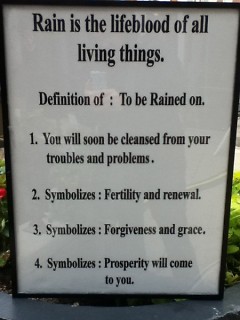Just across the street from the Van Andel Arena and slightly down from the many ArtPrize entries displayed at The Bob is a 750 pound, eight foot tall bronze sculpture of a man standing in a perpetual rain in front of the 50 Monroe building. The bronzed man stands with an umbrella over his head and a duck at his feet. A pool of water surrounds him and a short wall with plants placed on top encircles the structure, allowing a clear view of the piece from every angle.
D.B. Henkel, the sculptor who created the statue he named “Rainman,” describes himself as “a nice guy with a bad temper, not an outspoken kind of person.” He greets people walking by much the same way one would greet a guest arriving at your home: with a big smile and a hearty handshake.
When asked what art actually is, he thinks pensively.
“Art is different things to different people. Sometimes it is something visual, sometimes music, food or something else that enhances or titillates the senses. It should create some type of feeling, whether good or bad. It should make you talk and communicate…like ArtPrize for example: it brings people together to talk about it.”
How did Henkel prepare himself to be an artist? As a child he would sketch images of the people sitting beside him during church services. Afterwards, his parents and friends could always tell whose picture he sketched, and those people would get his drawings. He always had the support of his family and friends, and even today he says his family absolutely supports him one hundred percent.
He dreamed of becoming an architect, but being dyslexic, he changed his mind and decided to go into sports, then later realized he has been an artist all along.
When he was only 8 years old, Henkel entered a contest called the Scotts Fertilizer "Early Bird Contest" and won a “big savings bond.” After that, he became “the youngest artist on an art train that toured the country back in the early 1970’s," a cultural meets community project started by the Michigan Council for the Arts and later additionally funded by the National Endowment for the Arts. Art Train originated in Detroit and toured the U.S.A. via rail.
"It was basically a large rail car built into an art gallery," says Henkel.
Along the way, he understood that art is something he’s “just really good at,” and set aside his thoughts of everything else. He attnded Arizona State University, Kent State University and the University of Wyoming,
“I did study art in college, but I did not really learn anything there," Henkel says. Wanting to do something different and timeless, something that would not necessarily be dated, he moved to Traverse City so he could paint farm scenes, but found that it was way too easy and too common.
"Art is everywhere. I look at everything in life as art, and I look at art as the backbone of the world,” he says.
He took up sculpture along with all other forms and one day he “heard of a fellow up in Traverse City who got third place” in something called ArtPrize, and decided that he wanted to enter that contest also.
Henkel describes the long process of creating a piece of art like "Rainman." A small crowd gathers around the pool, and the sound of water fills the air as it trickles over the tall bronze body. Henkel says “rain is a negative connotation to some people, while to others it is actually one of the most positive, beautiful things in nature, the lifeblood of living things, with a sort of cleansing and purifying of the soul.”
Henkel has some advice for aspiring artists.
“Try to keep at it and find what you’re good at, then stick to it. You have to try everything in order to find out what you’re really good at, but once you do find out, stay with it and never stop, never give up practicing. If you don’t keep practicing, it will never get better. If it is painting then stick to that, if it is sculpture then stick to sculpting," he says. "Whatever it is you’re good at, don’t ever give up.”
What will Henkel do with the prize money if he wins?
"Family comes first," he says, "and I’m not into money that much. If I have a roof over my head and food on the table…that’s basically all I need.” The money would “probably help his family, and pay off a lot of bills.”
The artist's previous projects include a coffin made up of 10,000 cigarettes, and a spectrum of glass representing the rainbow of colors.
More information on D.B Henkel is available at his website.
The Rapidian, a program of the 501(c)3 nonprofit Community Media Center, relies on the community’s support to help cover the cost of training reporters and publishing content.
We need your help.
If each of our readers and content creators who values this community platform help support its creation and maintenance, The Rapidian can continue to educate and facilitate a conversation around issues for years to come.
Please support The Rapidian and make a contribution today.


